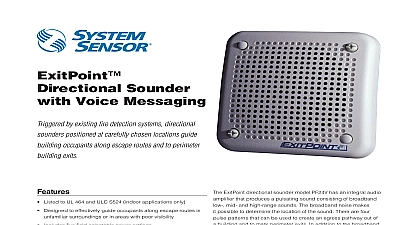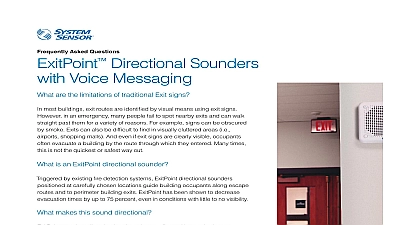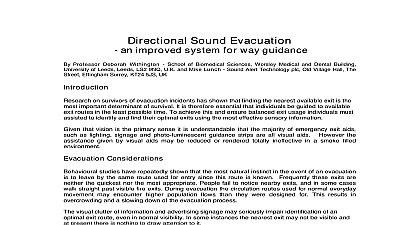System Sensor ExitPoint Directional Sounder

File Preview
Click below to download for free
Click below to download for free
File Data
| Name | system-sensor-exitpoint-directional-sounder-0349278561.pdf |
|---|---|
| Type | |
| Size | 1.62 MB |
| Downloads |
Text Preview
A P P L I C A T I O N S G U I D E Sounder Voice Messaging P P L I C A T I O N S G U I D E Sounder Voice Messaging 1 Introduction 2 Shortcomings of Traditional Methods 2 Directional Sound Aids Evacuation 2 Directional Sound Influences Human Behavior 3 Voice Messaging Aids in Guiding Occupants 3 2 Why Directional Sound Works 4 Psychoacoustic Theory 4 Acoustic Performance in Building Applications 4 Bandwidth 4 Sound Level Masking 5 Average Ambient Sound 5 Compatibility with Traditional Fire Alarm Notification Appliances 5 Compatibility with Voice Evacuation Systems 5 Reverberant Building Environments 6 3 Applicability of Building Codes and Standards 6 4 Locations for Directional Sounders 7 What are the exits where directional sounders can be used 7 What are the areas of refuge or areas of rescue assistance where directional sounders can be used 8 What are other means of egress components where directional sounders can be used 10 that may not be suitable for directional sounders 11 5 Directional Sound Installations 12 General 12 Type 1 Basic Installation 12 Type 2 Enhanced Installation 14 Special Considerations for Dead Ends 18 6 Positioning Directional Sounders on Wall and Ceiling Surfaces 19 7 Frequently Asked Questions 21 8 Glossary 22 23 of Illustrations 24 X I T P O I N T D I R E C T I O N A L S O U N D E R installation guide is the first effort of System Sensor to address the application of its new directional sounders for and structures The technology and initial applications of directional sound were developed at the University of under the supervision of Professor Deborah Withington and have become an accepted technology by international as an aid to evacuation While directional sound technology is a recognized and accepted technology over System Sensor considered it important and appropriate to obtain North American expertise to review the technology assist with the development of this application guide Experts with backgrounds in acoustic engineering human during fire and evacuations building and fire codes and fire protection engineering were key to this effort guide intends to promote an understanding and awareness of the benefits and capabilities of directional sound A focus of this guide is to provide information important to building design professionals specifying engineers fire system installers and enforcement authorities that will increase the probability of a proper installation and reduce possibility of misapplication of directional sounders in the commercial marketplace As with any new technology it anticipated that the role directional sound will play as a safety enhancement in buildings and structures will continue develop and that this installation guide will be revised and updated to reflect modifications or improvements of the features and refinements in directional sound applications in coming years 2007 1 application guide pro information to build design professionals engineers fire alarm system installers and authorities regarding 1 the technical or psy basis for directional sound technology and 2 implementation of directional sounders as an aid to exits egress routes or refuge areas sounders integrated with the building fire system are a supplemental audible means of iden exits and egress routes and can provide a means of the limitations of current exit signage and alarm The directional sound from the devices does not with the traditional audible alarm signals whether or bells however they are not a substitute for these fire alarm devices Directional sounders are intended to replace or be a substitute for fire alarm notification appliances There may be potential issues with the voice speakers for which guid is provided in the following sections of the guide of Traditional Methods alarm systems designed to initiate evacuation or relo of occupants use audible and visible notification that occupants will hear or see when the fire system operates Depending on the particular fire plan the occupants may be required to evacu or relocate immediately or prepare for such evacuation relocation Oftentimes occupants may not be familiar the building and its associated emergency egress and may have to rely on exit maps markings or to guide them to an exit refuge area or other of egress traditional maps markings and signage required by provide occupants a visible means for locating or a path to safety Generally exit s


